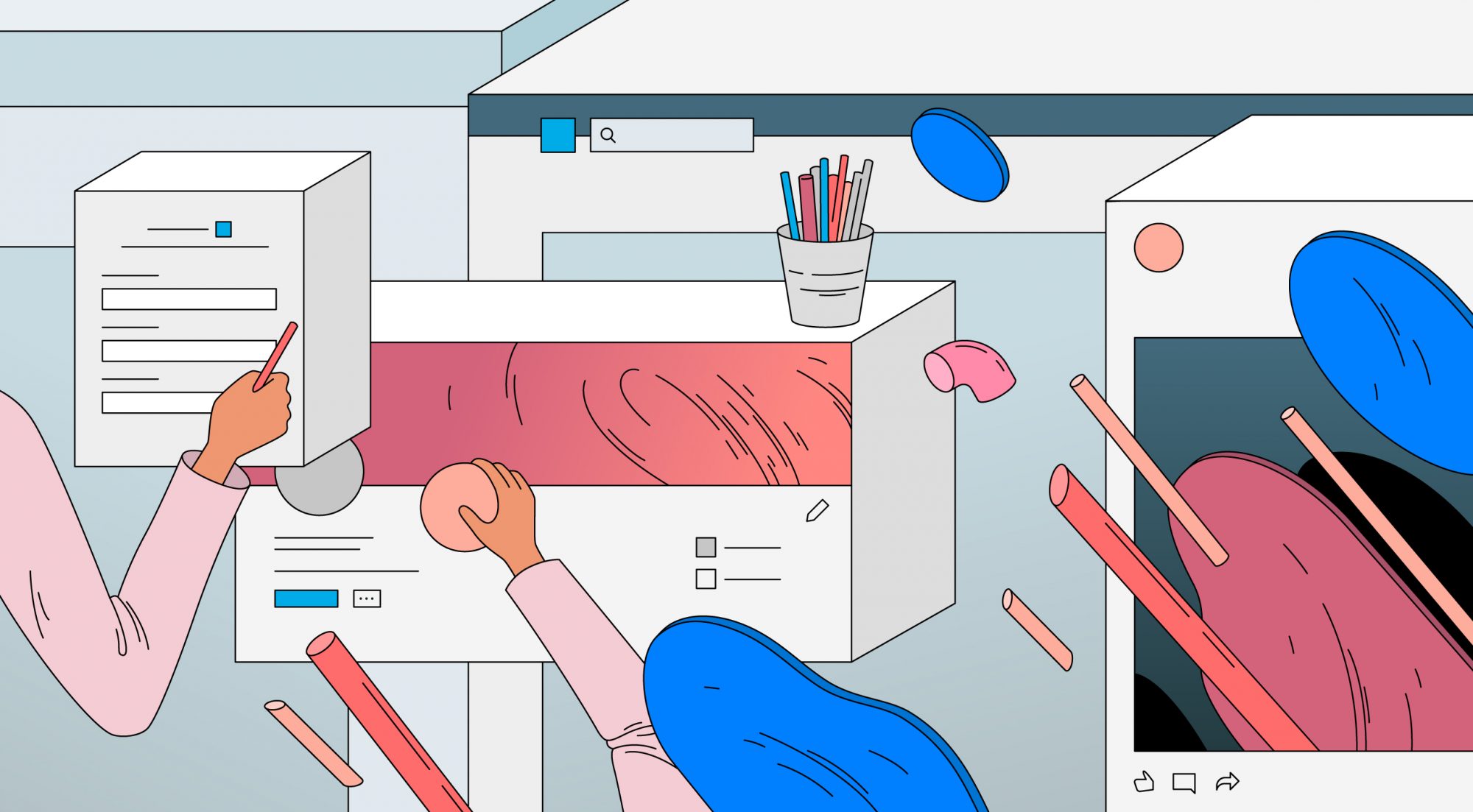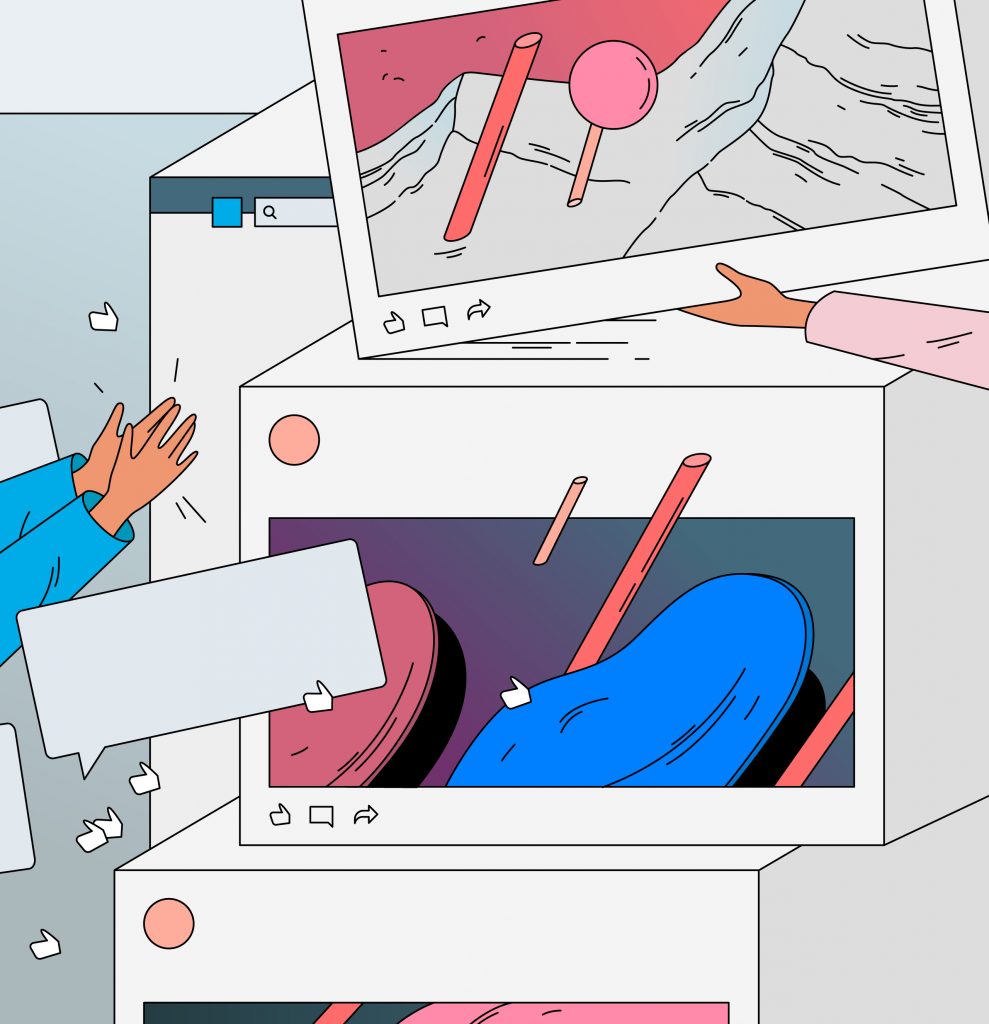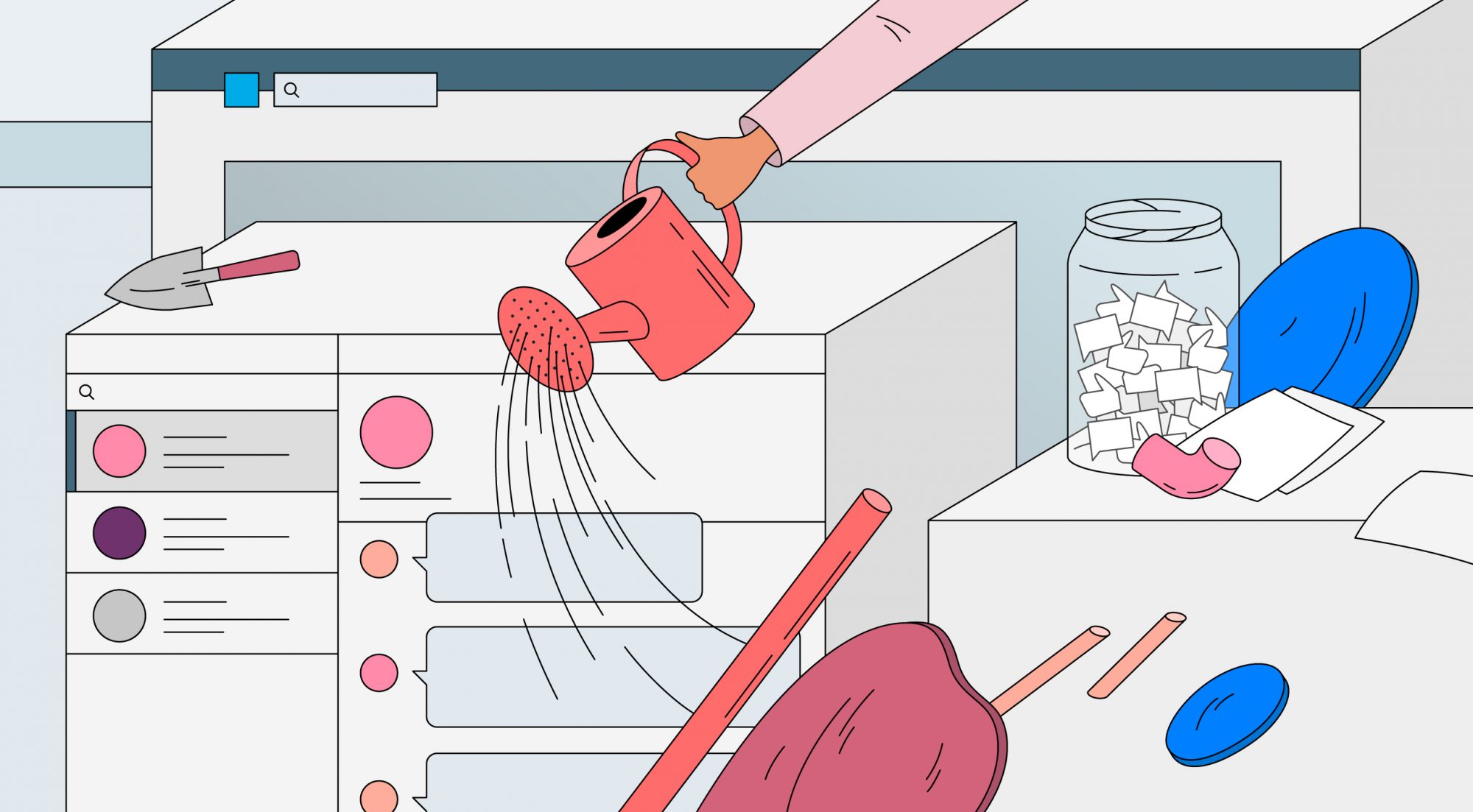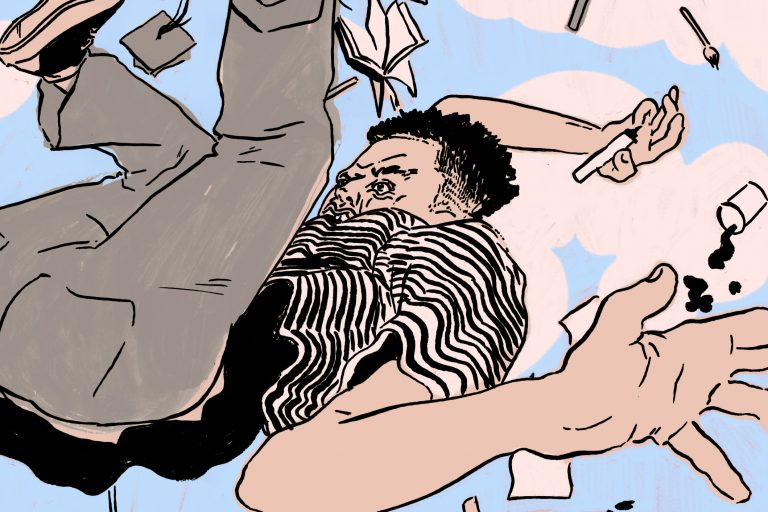
Thinking about Linking
Feel like LinkedIn can’t help you to build a career in the creative industries? Think again.
Words by Alec Dudson
Illustration by Julia Zass
The first time you use LinkedIn, it seems like an odd, foreign space. The user interface is rigid and dated, the process of filling in your profile is long-winded and formal, so maybe it’s just something you’re not going to bother using right? Wrong. This is a platform that will help you connect with people throughout your career who are in a position to secure the money that will enable you to bring your work to life. Once you shake off the obvious assumptions and start framing yourself in a dynamic way, it’s a great tool to have access to.
I used to think it was entirely useless and populated strictly by folk whose professional lives would never cross over with mine. I signed up initially as a kind of back-up plan so that I had some kind of online CV that might give me some options in the short-term. For years I checked in rarely and didn’t post much, then a few years ago I started to understand some of the ways to get real value from being on the platform and have been sharing these insights with students ever since.
I’ve put together a few key tips below that I hope will help you to start growing your network in a way that’s valuable to you and becomes genuinely beneficial for your career plans. This isn’t an exhaustive list by any means but offers a few do’s and don’ts that will up your game significantly.
Connection Requests
This is not strictly a numbers game. You’re not racing anyone to get to the point where LinkedIn just displays your network as 500+ connections. Be mindful about who you look to add to your network or who you accept. Bear in mind that by giving someone access to your profile, that you’re also granting them direct access to your other connections. As such, be vigilant and try to maintain a standard that reflects well on you. I’m not asking you to be elitist here and only accept people with senior job titles, but perhaps avoid adding randoms who you can’t vouch for, particularly if there seems no obvious reason as to why you’d be connected to them.
When it comes to sending invitations to connect, the majority of people don’t add a message to their request. It’s fine if I know the person and we’ve got an existing IRL relationship, but I generally don’t respond to these as I’ve got no idea what the context of the connection is. What do they want? What can they offer? Do we have a shared mission or experience? I’ve got no idea. In cases where I can see from someone’s job title (more about that in a minute) that there is a really clear and tangible way for us to collaborate, I might accept, but always by sending a message to initiate a conversation. If the trail runs cold, I’ll probably remove them as a connection at a later date.
Why is it so important to send a message I hear you ask? Well, to quote Content Strategist and Creative Producer Andrew Odong, “professional connections should be framed as a value exchange”. Andrew’s job usually revolves around him getting things done and to get things done, he needs to know and have a good relationship with people in all kinds of roles, industries and locations. What he’s learned over the years is that he can build far more functional relationships if he lets people understand exactly what he can do for them, as well as outlining what they can do for him. Rather than just send an empty request, he’ll explain why he wants to connect and outline the value he can offer to that person (it can be in the short-term or long term). Imagine receiving a request like that, where you know straight away where you stand and how this person can help you in the future. It’s far better than having absolutely no idea of why someone wants to add you, right?
If you’re reading this and thinking to yourself, “well that’s fine for you to say Alec, but I’ve got nothing of value to offer”, then I’d like to argue that you absolutely have. As a student or graduate, in a lot of cases, you’ve actually got sharper technical skills than a lot of people working professionally in your industry and at the very least, you offer a fresh perspective, boundless enthusiasm and the desire to learn and hone your craft. Your skills and attitude will generate great value for anyone you work for or with and no-one expects someone arriving in a junior role to be the finished article, so don’t be afraid to talk yourself up.
Job Title
Speaking of talking yourself up, here’s another thing that so many people can do in a moment to up their LinkedIn game. Please, please stop advertising yourself as a ‘student at…’ or ‘graduate from…’ in your profile. In this context, that information defines you to anyone who sees your profile (this tip also applies to your website and social media accounts). The impression it gives people is that you’re not confident in your work or yourself and as a result, it lowers expectations. I’m not saying that you need to remove your education from your profile, but whether you’re still studying, about to graduate or still looking for that first job after graduating, do yourself a favour and add a freelance, self-employed role that can act as your ‘current job’.
Now, that could be something pretty standard like ‘freelance illustrator’ or ‘stylist’ — which depending on the context of what your career aspirations are, could be perfect — or, you could see this as an opportunity to really step up your personal branding. Think about it like this, across pretty much all social platforms (and this is one of them) we tend to define ourselves by what we do. After an image and our name, our job title is usually the third piece of top-line information that someone sees. As such, it’s something I think that we should really design and use as a tool to get people excited about who we are and what it could be like to work with us.
Do your research, find out how the people you aspire to emulate frame themselves. I love Dot Lung’s ‘Mother of Social Media Dragons’ job title. I think you’ll agree that it’s a damn sight more eye-catching than ‘Social Media Strategist’. These things don’t always have to be super serious either. I know that LinkedIn looks like a haven for middle-class white guys wearing ties, but there’s so much more to it than that, there’s actually a really fresh, exciting wave of changemakers out there, but you’ll only see that if you consciously build your network around those principles. Confidently presenting yourself with a job title that grabs attention — or at the very least, frames you as a professional first and foremost — will really help you to connect with those people. There is often an element of ‘faking it ’til you make it’ here, but be safe in the knowledge that pretty much everyone out there is doing that on some level. By framing yourself aspirationally, you’ll start to catch the attention of people who can help you to really fulfil, manifest and grow into that role.
If your portfolio is strong and you don’t tell people that you’re a student or recent graduate, then they’ve got no reason to think of you as one. By admitting that you’re inexperienced, you’re massively undervaluing yourself and giving clients or employers a reason to do the same. Change it, now.

What to Post
Content! Just because this is LinkedIn, it doesn’t mean that you can’t or shouldn’t share the amazing work you do, in fact, that’s exactly how you should be using the site. It’s not often framed as a social network, but I think in a lot of respects it functions just like one. You post engaging content and your followers like and comment, as they like and comment, their followers see your post and they like, comment and look to connect and so on ad infinitum.
When you’re writing a caption to accompany the visual aspect of your post, interesting things to bring up might be the process (tagging anyone who you collaborated with), the concept (as your audience on LinkedIn is hopefully far more diverse than the intended audience of the piece of work) and some things that you’ve learned, liked or found challenging about the project. If you don’t have much work to share, either make some and get feedback from your audience or consider posting a short, timely opinion on a subject that aligns with your desired career. This is an interesting forum for discussion and that can be a great way to start conversations with people who you might feel shy about connecting with directly.
Interaction
In just the same way that liking and commenting on other people’s posts on Instagram grows your audience, exactly the same applies here. Put simply, the more you put in, the more you get out. Now, in the interest of your ongoing mental health, please understand that I’m not saying you should be on this all day, every day, but dedicating a little time each week to check in with your connections, give them feedback on what they’re doing and finding out what’s out there will help to establish you as a professional in the eyes of your audience. If you only post and never comment or like, it’s going to be far less likely that your posts achieve any major traction.
Follow Up
Relationships are hands down the most important factor in securing work. In an ideal world, we’d all get job offers and positive responses to proposals within an hour or so of reaching out to someone the first time. In reality, these things take a little longer. Don’t be despondent if someone doesn’t get back to you straight away or can’t help you out the first time you get in touch, instead stay on their radar, be supportive and check in regularly. The more that relationship develops, the more likely it is that it’ll significantly impact your career. These things are like houseplants, neglect them and you can have no complaints when they wither and die. Some are harder to keep going than others, but often and frustratingly, they’re the ones that are the most rewarding.
Get a picture taken
Find a pal who is great with a camera and if you haven’t got the money to pay them, find a way to make or do something for them that you can trade in order to get a really nice photograph of you. Strictly no pictures of you on a night out, this is not Tinder, repeat, this is not Tinder. You don’t have to wear formal clothing or have a super serious look on your face, but a nice professionally taken photo will go a long way to making you look legit.
Writing about your work
Some people go into granular detail when describing their work positions and experiences, some put together a bullet point list with a bunch of phrases that you struggle to even understand. Don’t be intimidated. This site is used by people from pretty much every business sector out there and many of those sectors have their own language. Don’t feel like you have to match them, but if these people are relevant to you, it’s a good idea to learn how to decode their prose. Either way, it’s far more important to see how the people whose careers you would like to emulate write about their work and borrow ideas from them. Above all else though, write with clarity and confidence. If you can project ownership of your work and a passion for it, you’ll be absolutely fine, whether it reads like anyone else’s profile or not.
Be aware of irony/humblebrags
LinkedIn is a far from perfect space and there are some very good Twitter accounts out there that can help to keep you grounded when it comes to humblebrags and to help you to realise what doing it just plain wrong looks like. It’s terrible when people disappear up their own rear ends, but that’s not what you’re here to do, you’re here to share your passion with the world and make LinkedIn a far more interesting and exciting place.

This year we’re building an archive of advice posts that aim to empower young creatives by offering an experienced perspective on some of the fundamentals that will help you to get set up. If you feel like you’re in a position to pass on some of your wisdom, head to our submissions page and pitch us a story. If this has been valuable to you or you know someone who it will resonate with, please use our new sharing tool in the header to spread the word. Thinking About Linking was written by our Editor-in-chief Alec Dudson, who you can follow on Twitter here. Illustrations come from Moscow-based designer and illustrator Julia Zass. Her beautifully curated Insta feed is just a click away so be sure to follow her.








